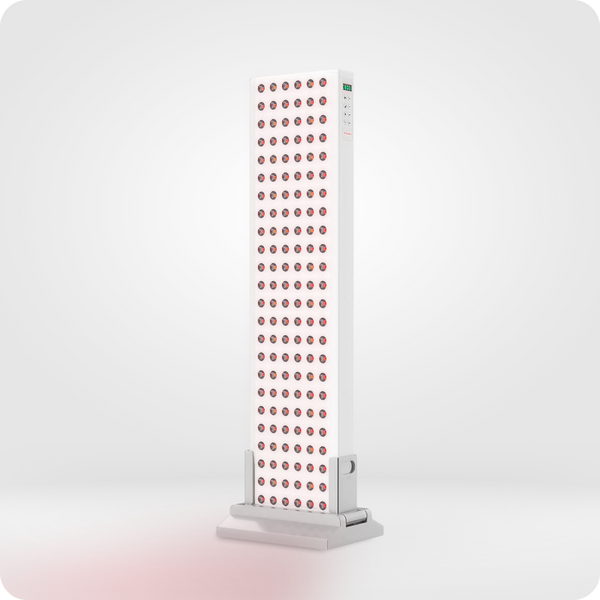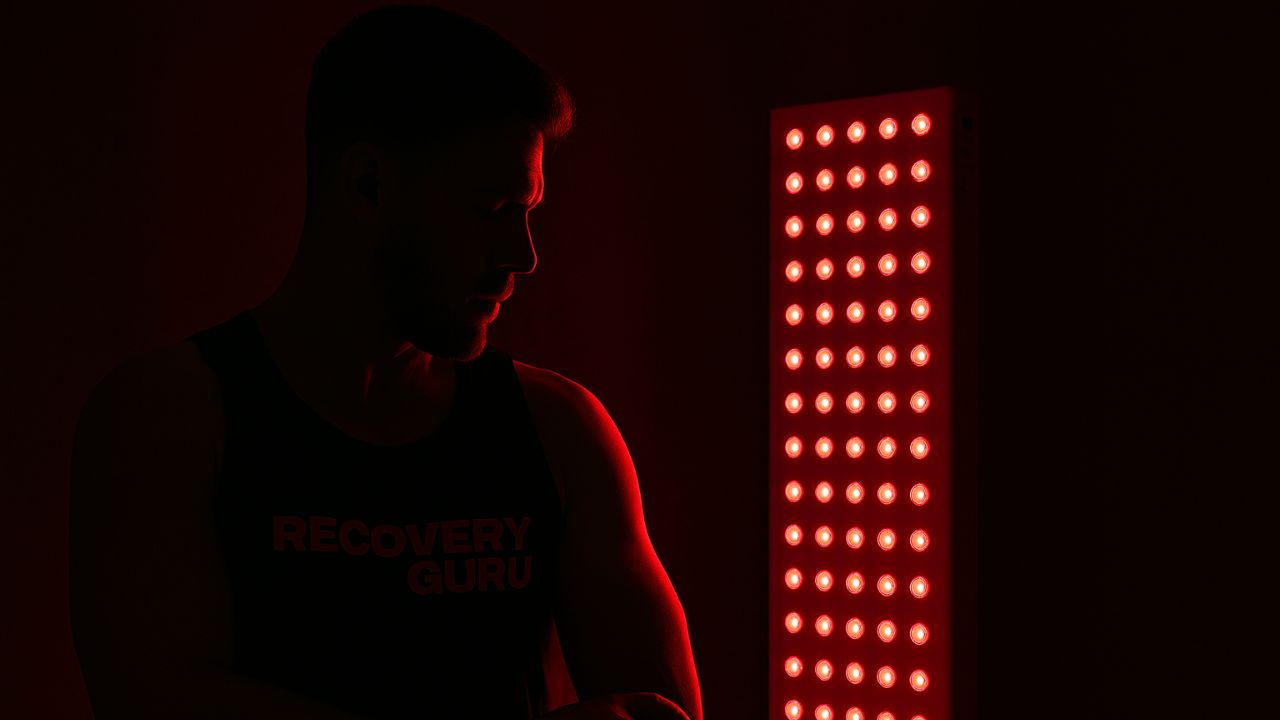I’ve spent the last four weeks using the Infraredi Australia Pro Max panel, and I’m excited to share my experience in this review. As a writer who spends hours sitting at a desk, I was curious to see if adding red light therapy to my routine could boost my wellness and fitness. This is my personal Infraredi Australia review, focusing on the Pro Max red light therapy panel and touching on Infraredi’s other panels for different needs. Along the way, I’ll also discuss how I integrated it into a busy schedule (especially on hectic Thursdays and Fridays) and the benefits I noticed – from improved planking endurance to better recovery.
Red light therapy has been gaining popularity for its potential health benefits, and I wanted to see firsthand what it could do for me. Below, I break down why I chose the Infraredi Pro Max, how I used it, the results I observed, and some tips (like using eye protection) to get the most out of it. I’ll also compare the Pro Max with Infraredi’s smaller panel (the Mini) and share a suggestion for readers outside Australia looking for an alternative device.
Why I Chose The Infraredi Pro Max
- Solid, Medical‑Grade Build
Built with an aluminum frame and designed to medical-grade standards. It’s listed in Australia’s ARTG and meets electrical safety standards (AS/NZS IEC 60601). - Powerful Dual‑Lens LEDs: Equipped with 150 red + 150 near-infrared LEDs—each LED packs 6 Watts (two 3 W chips) using dual-lens technology for better light spread.
- Multi‑Wavelength Light: Uses four bioactive wavelengths: red at 630 nm & 660 nm, and near-infrared at 830 nm & 850 nm.
- Pulsing+ Mode: Lets you pulse the red & NIR light at frequencies between 0–9,999 Hz. (Note: red light won’t pulse below 60 Hz for safety.)
- Dimming+ Mode: Adjust brightness smoothly from 100% down to 1% to match your mood or purpose.
- Power consumption: around 900 watts.
- Irradiance rate: approximately 250 mW/cm²—higher than many other models.

Editor’s Rating: 4.3/5.0
When I decided to invest in red light therapy for home use, I knew I needed a device that provided full coverage. Being fairly tall and wanting to target multiple areas (from my back and shoulders to my legs), a larger panel made sense. Infraredi’s Pro Max panel stood out as a top-tier option for full-body exposure. Compared to smaller devices, the Pro Max promised a broad light coverage area and high power output, meaning I could treat my whole front or back in one session without moving the panel around.
Another reason I went with Infraredi Australia’s products was their reputation for quality and local customer support. Since I’m based in Australia, having a home-grown company (they also have international retail available) behind the product gave me peace of mind in terms of warranty and service. The “Pro Max” also sounded like it was designed for people who are serious about red light therapy, and I was ready to be serious about reaping the benefits.
Finally, as someone who likes to multitask and maximise my wellness routines, I envisioned using the red light panel while doing some exercises or stretches. The large Pro Max panel allowed me to plank, stretch, or do yoga in front of it and still get consistent light on a large portion of my body. In short, I chose the Pro Max for its size, power, and convenience for habit-stacking (more on that later).
Setting Up and My Daily Routine
Setting up the Infraredi Pro Max was straightforward. The panel arrived securely packaged, and it was evident this thing is built like a tank – sturdy and high-quality. I found a spot in my home office to prop it up (you can mount it or use a stand; I leaned it against the wall at first). The device came with clear instructions, and within minutes I had it powered on. The panel emits a deep red glow mixed with near-infrared light. (Infraredi’s panels use a combination of red light wavelengths, typically around 660 nm for visible red and 850 nm for near-infrared, to penetrate different depths of the body’s tissues.)
Being a writer with a busy schedule, I had to be intentional about scheduling my red light therapy sessions. I aimed for 10-15 minute sessions, 4-5 times a week. On ideal days, I’d do a session in the morning right before starting work – it felt like it gave me a gentle energy boost and helped me wake up (indeed, some say morning is the best time to use red light therapy for an energising effect). On days when mornings weren’t possible (especially Thursdays and Fridays when deadlines loomed), I would take a short evening session instead, to unwind and help with muscle recovery after any workout. I found that consistency was key: sticking to near-daily use made the benefits more noticeable by the second and third week.
One way I made sure to use the panel regularly was by habit-stacking. I paired my red light therapy time with other activities. Often, I’d do a plank or some core exercises in front of the panel. Planking in front of the Pro Max became a mini ritual for me. I’d set a timer for a 60-second plank, turn on the panel, and focus on the red glow to distract from the strain. On other days, I’d simply practice mindfulness or read a few pages of a book while bathing in the light (with eye protection on, of course).
Performance and Health Benefits I Noticed
Over four weeks, I observed several positive changes that I’d attribute to using the Infraredi Pro Max panel consistently. Keep in mind this is my personal experience, but it aligns with many claims about red light therapy benefits:
Increased Core Strength and Endurance: This was a pleasant surprise. As I mentioned, I usually hold a plank for about 45-60 seconds before my muscles tremble. After a couple of weeks of doing planks under the red light, I found I could push past 80 seconds. It’s hard to say if it was purely psychological (the red light perhaps distracts me or makes the plank more engaging) or physiological. Some research suggests red/infrared light can improve muscular endurance and reduce fatigue by boosting cellular energy (ATP) production and reducing inflammation (Vanin et al., 2018). Whatever the reason, I clearly noticed I could plank longer and my core felt stronger.
Better Muscle Recovery and Less Soreness: On days I did a harder workout or a longer plank, I typically would get some muscle soreness. I noticed that when I used the red light panel post-workout, my muscles felt less achy the next day. Infraredi Pro Max delivers a generous dose of near-infrared light that penetrates deep into muscles. By week 4, I was convinced that my recovery had improved; I could exercise more frequently with less downtime from soreness. This lines up with studies and anecdotes about red light therapy being great for relieving muscle pain and speeding up recovery (red light therapy for muscle pain is a well-documented benefit).
Improved Mood and Focus: Sitting in front of a warm red glow has a meditative quality. I often felt more relaxed yet mentally clear after sessions. As a writer, I sometimes experience afternoon slumps or brain fog, but on the days I used the Infraredi panel around lunch, I felt a noticeable pick-up in my mental energy. There’s ongoing research into red light therapy for brain health, some studies have found it can support cognitive function and mood by improving circulation and reducing oxidative stress in the brain. In my case, even if it was just a placebo effect, I’ll take it because I certainly felt more focused and upbeat.
Skin Health and Appearance: I primarily got the Pro Max for muscle and overall wellness benefits, but I’d be remiss not to mention skin. The red light (not the invisible near-infrared, but the 660 nm red) is known to be beneficial for skin rejuvenation. After a month, I feel like my skin has a bit more of a “glow.” I had a couple of small acne spots that seemed to heal faster than usual. I can’t scientifically confirm these changes, but given that red light therapy for skin is backed by research (Avci et al., 2013) – it’s used to boost collagen, reduce wrinkles, and heal damage – I wouldn’t be surprised that it helped my complexion subtly. It’s a nice bonus for me, even though skin was not my main focus.
It’s worth noting that everyone’s results can differ. Factors like frequency of use, distance from the panel, and individual health can affect outcomes. I made sure to sit or stand at the recommended distance (about 6-12 inches from the panel for maximum intensity). I also consistently used it; by the end of week 2, I suspect some cumulative effects kicked in, and that’s when I really started noticing the above benefits.
Eye Safety and Comfort During Sessions
One thing I learned quickly is the importance of eye protection when using high-powered red light panels like the Pro Max. The Infraredi panel is intensely bright, and while red and infrared light are generally safe, staring into any bright light can cause eye strain. The kit thankfully included a pair of protective goggles – and I made it a habit to wear them every session. In my first couple of sessions, I tried just closing my eyes or looking away, but even with eyes closed you can see the red through your eyelids and it felt uncomfortable after a few minutes. Prolonged use without eye protection could lead to headaches or strain, so goggles are a must in my opinion, especially if you’re doing something like I was (planking face towards the panel).
Wearing the goggles took a little getting used to (they remind me of tanning bed goggles, snug and light-blocking). Once they’re on, I can relax and let the light do its work without worrying about my eyes. In fact, using the goggles allowed me to fully focus on my exercise or relaxation without distraction. If you pick up any high-intensity red light device, definitely use the eye protection provided – it makes the experience safer and more comfortable.
Infraredi Panel Options: Pro Max vs Other Panels
One thing I learned quickly is the importance of eye protection when using high-powered red light panels like the Pro Max. The Infraredi panel is intensely bright, and while red and infrared light are generally safe, staring into any bright light can cause eye strain. The kit thankfully included a pair of protective goggles – and I made it a habit to wear them every session. In my first couple of sessions, I tried just closing my eyes or looking away, but even with eyes closed you can see the red through your eyelids and it felt uncomfortable after a few minutes. Prolonged use without eye protection could lead to headaches or strain, so goggles are a must in my opinion, especially if you’re doing something like I was (planking face towards the panel).
Wearing the goggles took a little getting used to (they remind me of tanning bed goggles, snug and light-blocking). Once they’re on, I can relax and let the light do its work without worrying about my eyes. In fact, using the goggles allowed me to fully focus on my exercise or relaxation without distraction. If you pick up any high-intensity red light device, definitely use the eye protection provided – it makes the experience safer and more comfortable.
| Infraredi Panel | Description & Key Features | Best Suited For |
|---|---|---|
| Infraredi Pro Mini | Compact, lightweight, and space-saving. Uses 660 nm red and 850 nm near-infrared light. Easily fits on a desk or shelf and targets specific areas like face or joints. | Ideal for small apartments, travel, or habit-stacking in tight spaces (e.g., working, reading, stretching). Great if you want targeted therapy without dedicating floor space. |
| Infraredi Pro Semi | Medium-sized panel offering more coverage than the Mini. Suitable for upper or lower body sessions. Includes stand or wall-mount options, and higher power output. | Perfect for everyday home users with moderate space who want reliable treatment for multiple body zones. Doesn’t require the commitment or setup of a full-body panel. |
| Infraredi Pro Max | Full-body panel with strong irradiance and broad LED coverage. Covers head-to-toe in a single session. Best used at 6–12 inches away while standing or exercising. | Best for committed users, wellness enthusiasts, and those with a dedicated space. Ideal for full-body recovery, post-workout use, or wellness routines for multiple people. |
As you can see, the Infraredi Mini shines in portability and convenience. I got to briefly try a friend’s Mini and was impressed – it’s perfect if you only have a tiny apartment or you want to shine the light on a specific area while, say, watching TV or working on your laptop (easy to position next to you). You can comfortably habit-stack with the Mini, like doing breathwork or reading, because it’s not as overwhelming in brightness for a small area and easy to set up anywhere.
The Infraredi Pro (standard size) panel would be a good middle-ground option. I didn’t personally own this one, but given my experience with the Pro Max, I can imagine the standard panel would still offer robust power but with a bit less coverage. If you don’t need full-body exposure all at once, the mid-size panel can still treat a large portion of your body (you might do top half then bottom half in separate sessions). It’s also a bit more budget-friendly and easier to move compared to the Pro Max.
For me, the Pro Max ended up being a fantastic choice because I do value the full coverage. I can stand or exercise in front of it and know that the light is hitting all the key areas I care about – I don’t have to constantly reposition myself or the device. It does take up more space; in my case I have it in a corner of the room and it is about as tall as a person. If you’re considering one, be sure you measure out the space where you’ll use it, and consider the panel’s weight if you plan to mount it on a wall or door.
Making Red Light Therapy a Habit (Even on Busy Days)
One challenge I anticipated was finding time for yet another wellness habit. As mentioned, my weekdays can get very busy (Thursdays and Fridays in particular often meant I was swamped with writing deadlines). However, because the Infraredi panel is so easy to use, I managed to integrate it without too much trouble.
Here are a few tips from my experience on making red light therapy with the Pro Max a sustainable habit:
Keep the panel accessible: I kept the Pro Max panel in the same room where I exercise and work. Seeing it regularly was a visual cue to use it. If I had to drag it out of a closet each time, I probably would have skipped sessions on hectic days.
Use a timer and routine: I treated it like a short “break” or a ritual. For instance, on Friday afternoons, I’d take a 10-minute break, turn on the panel, and do a gentle stretch. This was refreshing and didn’t feel like it took time away – it actually helped me recharge and return to work with more focus.
Try different times of day: While I enjoyed morning sessions for an energy boost, I also found evening sessions useful, especially after a long writing day when my neck and back were stiff. The warm light helped me wind down. Everyone is different, so find your sweet spot – and remember the best time to use red light therapy can depend on your goals (e.g., morning for energy, evening for recovery).
Listen to your body: If I ever felt a bit drained or had a slight headache (rare, but happened once when I overdid a session at 20 minutes), I took that as a sign to rest and maybe skip the next day. Red light therapy is generally very safe, but more isn’t always better – consistency beats marathon sessions.
By the end of the four weeks, using the Infraredi panel became almost second nature. It’s a habit I plan to keep. In fact, I’ve grown to enjoy those few minutes of red light as “me time” – a chance to disconnect from screens and do something good for my body.
Final Thoughts and Alternatives
After a month with the Infraredi Pro Max, I’m genuinely happy with the purchase. I can now see why it’s widely regarded as one of the best red light therapy panel manufacturers in Australia. It delivered on its promises of a high-quality, effective red light therapy experience. My plank times improved, my post-exercise soreness diminished, and I even noticed benefits like better mood and a touch of skin glow. As a busy professional, I value anything that can enhance my health routine without eating up too much time, and this panel fits that bill nicely.
Infraredi Australia has impressed me with their panels. If you’re in Australia and looking for a reliable red light therapy device, I’d definitely suggest considering their lineup (choose the model that fits your space and needs). And don’t forget the eye protection – your eyes will thank you.
For readers not based in Australia, you might be wondering how to get a similar experience. One alternative I’d gently recommend is checking out NovaaLab’s red light therapy catalogue. NovaaLab is known for producing quality red light devices as well, and they could be a great option if Infraredi’s products are not easily accessible in your region. The key is to go for a reputable brand that uses appropriate wavelengths and has good reviews.
In conclusion, this Infraredi Australia review reflects one person’s experience, but it aligns with the broader trend: red light therapy is a promising wellness tool. Whether you’re aiming to relieve muscle pain, improve skin, boost your exercise performance, address nerve pain, or just invest in some self-care time, a panel like Infraredi’s could be a worthwhile addition to your routine. I’m looking forward to seeing how I feel after a few more months of this – if the first four weeks are any indication, things are looking bright (literally and figuratively!).
References
Vanin, A. A., Miranda, E. F., de Carvalho, P. D. T., Brito, C. J., de Oliveira, Z. F., Miranda, H. L., & de Paiva, F. O. (2018). Photobiomodulation therapy and exercise performance: a systematic review and meta-analysis. Lasers in Medical Science, 33(8), 1813–1827. DOI: 10.1007/s10103-018-2532-3
Avci, P., Gupta, A., Sadasivam, M., Vecchio, D., Pam, Z., Pam, N., & Hamblin, M. R. (2013). Low-level laser (light) therapy (LLLT) in skin: stimulating, healing, and restoring. Seminars in Cutaneous Medicine and Surgery, 32(1), 41–52. DOI: 10.12788/j.sder.0023




